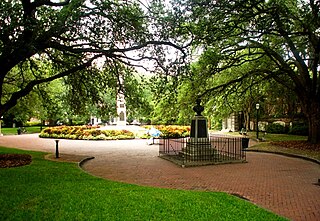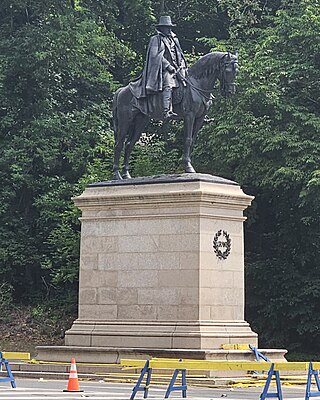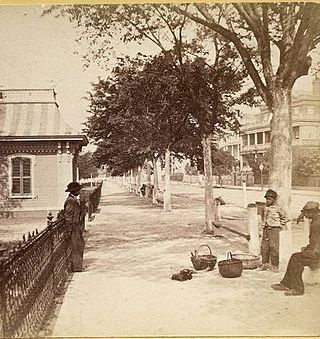
Fort Sumter is a sea fort built on an artificial island near Charleston, South Carolina to defend the region from a naval invasion. It was built after British forces captured and occupied Washington during the War of 1812 via a naval attack. The fort was still incomplete in 1861 when the Battle of Fort Sumter occurred, sparking the American Civil War. It was severely damaged during the battle and left in ruins. Although there were some efforts at reconstruction after the war, the fort as conceived was never completed. Since the middle of the 20th century, Fort Sumter has been open to the public as part of the Fort Sumter and Fort Moultrie National Historical Park, operated by the National Park Service.

Sullivan's Island, historically known as O'Sullivan's Island, is a town and island in Charleston County, South Carolina, United States, at the entrance to Charleston Harbor, with a population of 1,791 at the 2010 census, and 1,891 people in 2020. The town is part of the Charleston metropolitan area, and is considered a very affluent suburb of Charleston.

William Moultrie was an American planter and politician who became a general in the American Revolutionary War. As colonel leading a state militia, in 1776 he prevented the British from taking Charleston, and Fort Moultrie was named in his honor.

The Battle of Fort Sumter was the bombardment of Fort Sumter near Charleston, South Carolina by the South Carolina militia. It ended with the surrender by the United States Army, beginning the American Civil War.

Fort Moultrie is a series of fortifications on Sullivan's Island, South Carolina, built to protect the city of Charleston, South Carolina. The first fort, formerly named Fort Sullivan, built of palmetto logs, inspired the flag and nickname of South Carolina, as "The Palmetto State". The fort was renamed for the U.S. patriot commander in the Battle of Sullivan's Island, General William Moultrie. During British occupation, in 1780–1782, the fort was known as Fort Arbuthnot.

Fort Sumter and Fort Moultrie National Historical Park is a United States National Historical Park located in Charleston County, in coastal South Carolina. It mainly protects Fort Sumter, Fort Moultrie, the Charleston Light and Liberty Square. It was known as Fort Sumter National Monument until it was renamed in the John D. Dingell Jr. Conservation, Management, and Recreation Act, signed March 12, 2019.

The Battery is a landmark defensive seawall and promenade in Charleston, South Carolina. Named for a civil-war coastal defense artillery battery at the site, it stretches along the lower shores of the Charleston peninsula, bordered by the Ashley and Cooper Rivers, which meet here to form Charleston harbor.

Washington Square is a park in downtown Charleston, South Carolina. It is located behind City Hall at the corner of Meeting Street and Broad Street in the Charleston Historic District. The planting beds and red brick walks were installed in April 1881. It was known as City Hall Park until October 19, 1881, when it was renamed in honor of George Washington. The new name was painted over the gates in December 1881.

The South Carolina State House is the building housing the government of the U.S. state of South Carolina, which includes the South Carolina General Assembly and the offices of the Governor and Lieutenant Governor of South Carolina. Located in the capital city of Columbia near the corner of Gervais and Assembly Streets, the building also housed the Supreme Court until 1971.

The Battle of Sullivan's Island or the Battle of Fort Sullivan was fought on June 28, 1776, during the American Revolutionary War. It took place near Charleston, South Carolina, during the first British attempt to capture the city from American forces. It is also sometimes referred to as the first siege of Charleston, owing to a more successful British siege in 1780.

William Shakespeare has been commemorated in a number of different statues and memorials around the world, notably his funerary monument in Stratford-upon-Avon ; a statue in Poets' Corner in Westminster Abbey, London, designed by William Kent and executed by Peter Scheemakers (1740); and a statue in New York's Central Park by John Quincy Adams Ward (1872).

Major General George Henry Thomas, also known as the Thomas Circle Monument, is an equestrian sculpture in Washington, D.C. that honors Civil War general George Henry Thomas. The monument is located in the center of Thomas Circle, on the border of the downtown and Logan Circle neighborhoods. It was sculpted by John Quincy Adams Ward, best known for his work on the statue of George Washington in Wall Street, Manhattan. Attendees at the dedication in 1879 included President Rutherford B. Hayes, Generals Irvin McDowell, Philip Sheridan, and William Tecumseh Sherman, senators and thousands of soldiers.

More than 160 monuments and memorials to the Confederate States of America and associated figures have been removed from public spaces in the United States, all but five since 2015. Some have been removed by state and local governments; others have been torn down by protestors.

The Defenders of Fort Moultrie, also commonly known as the Jasper Monument, is a monument in Charleston, South Carolina, United States. Located in White Point Garden, the monument depicts Sergeant William Jasper and was dedicated in 1877 to all South Carolina militiamen involved in the Battle of Sullivan's Island during the American Revolutionary War.

Confederate Defenders of Charleston is a monument in Charleston, South Carolina, United States. The monument honors Confederate soldiers from Charleston, most notably those who served at Fort Sumter during the American Civil War. Built with funds provided by a local philanthropist, the monument was designed by Hermon Atkins MacNeil and was dedicated in White Point Garden in 1932. The monument, standing 17 feet (5.2 m) tall, features two bronze statues of a sword and shield-bearing defender standing in front of a symbolic representation of the city of Charleston. In recent years, the monument has been the subject of vandalism and calls for removal as part of a larger series of removal of Confederate monuments and memorials in the United States.

The Denmark Vesey Monument is a monumental statue in Charleston, South Carolina, United States. The monument was erected in 2014 in Hampton Park and honors Denmark Vesey, a freedman who lived in Charleston and was executed in 1822 for plotting a slave revolt. It was designed by American sculptor Ed Dwight.

The equestrian statue of Ulysses S. Grant is a public monument in Philadelphia, Pennsylvania, United States. Located in Fairmount Park, the monument honors Ulysses S. Grant, who served as a general in the Union Army during the American Civil War and later as President of the United States. The monument was designed by Daniel Chester French and Edward Clark Potter and consists of an equestrian statue atop a pedestal. The statue was dedicated in 1899.
The loyal slaves monument is an 1896 monument in Confederate Park in Fort Mill, South Carolina, dedicated to the proposition that slaves were loyal and gladly helpful to the Confederacy, and honoring them.


















